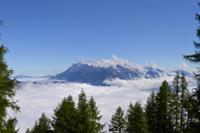
Climbers on Mont Blanc | H. Qualizza
Blog home / Climbing Mont Blanc: A Trekker's Guide
Clearly visible above the beautiful mountain town of Chamonix, Mont Blanc, the highest mountain in western Europe (4810m/15,780ft), was first climbed in 1786, and the ascent gave birth to modern day mountaineering.
Now a mecca for budding mountaineers, the peak and surrounding areas offer world class alpine trekking and climbing opportunities, right in the heart of Europe.
While summitting Mont Blanc is a serious endeavour, this guide will make it well within reach for the fit and experienced trekker.
Routes for climbing Mont Blanc
There are two main routes for climbing Mont Blanc: the Gouter ‘normal route’ and the ‘Trois Monts’, both of which are rated Alpine grade PD – that is peu difficile, meaning a bit difficult. We recommend the Gouter route as it generally has the highest success rate for reaching the summit and is considered the safer route.

Who is it suitable for?
Whilst the range has attracted the attention of world-class alpinists from around the globe for its challenging routes for centuries, there are also many options available to the novice climber under the guidance of experienced guides.
Mont Blanc is often underestimated; a high level of fitness and experience walking or scrambling over uneven and steep terrain is essential as you will need to do so at a good speed. A good speed is the ability to walk or ascend 400 metres in an hour at altitudes in excess of 3000 metres.
To participate in the Mont Blanc Ascent, prior mountaineering experience is an advantage but not essential. Most important is an excellent fitness level, with a good level of experience walking in the mountains on snow and ice.
What to expect on the ascent
When climbing Mont Blanc, the walk is often on uneven rock and ice, with exposed sections of trail for a vast majority of the climb; balance and tenacity are very important.
Expect to hike for 6-to-12-hour days with up to 800 to 1600 metre vertical gains in elevation. The snow slopes will be up to 35‑40 degrees in parts and there is also rock climbing involved in some sections.
Combined with exposure and the possibility of adverse weather conditions, it can be difficult for those who have not experienced this type of climbing before. Additionally, you will be wearing stiff mountaineering boots and crampons which take some getting used to.

How to prepare for the climb
The best preparation for this ascent is extended periods of hard-paced walking with a pack in mountainous terrain; legs and lungs should be the focus. As mentioned above, the ability to ascend quickly at a rate of 400 metres in one hour is a minimum requirement. If you are not fit and strong, your chances of summitting are vastly reduced. Remember, it is up to your guide to decide whether or not you are fit to attempt the summit.
You should aim to start your preparation six months or more in advance of taking the trip.
Practice on uneven ground, so that you are accustomed to uneven footings, basic rock climbing, and at the least, scrambling should also be a part of your training regime. Incorporate running and cycling in hilly regions into your exercise programme to further prepare you well for this trip. You can learn the technical skills to get you to the top in your final days of training; however, your fitness and preparation are your responsibility and key to a successful climb.

Conquer Western Europe's highest mountain
Our eight-day itinerary is designed to allow fit and experienced walkers, who have little or no experience in alpine skills, to appreciate the exhilaration of summiting an alpine peak.

Acclimatisation and basic technical training are part of our programme for the first three days as we venture into the spectacular mountains of Aiguille du Tour and Petite Fourche, crossing beautiful glaciers under a stunning backdrop of snowy peaks and jagged mountains.
During these days our guides will train you in the use of an ice axe, crampons and basic rope techniques, arming you with the right alpine skills for the summit bid. Fully prepared, we focus on climbing Mont Blanc.
We schedule three days for climbing Mont Blanc, to allow two chances to reach the summit, giving our groups a significant advantage and a better chance of success. Travelling in teams of two clients to one qualified high-altitude mountain guide during the ascent, and often roped up, you will learn to work as a team and move together efficiently in a challenging mountain environment.
Summit day is a long and tiring day, however, the views from the summit are magnificent and are well worth your efforts.
Feeling inspired? Find out more about climbing Mont Blanc on our Mont Blanc Ascent trip >>